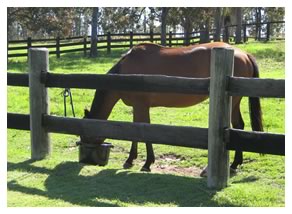
Home › Chiropractic + Acupuncture for Horses
Frequently Asked Questions
How will your horse feel after treatment?
Most horses feel really well and may be quite “full of themselves”. For this reason it is best to keep the horses in a small paddock for a few days. Boxing is not desirable, except for horses that go silly in the paddock.
Sometimes horses will feel out of sorts and even a bit sore. More often than not this is a good sign and is associated with the body returning to a healthier state. It has to do with the freeing up of arthritic spinal joints and also changes to a whole lot of muscle reactions and even co-ordination. This should pass in 24-48 hours.
If you are at all concerned please call me.
This reaction is less likely to happen after subsequent treatments. Normally, because of this possibility horses are not treated any closer than 48 hours to an event, and at the first treatment 4 days between an event and treatment are preferred.
What do you do with your horse after a treatment?
Horses ideally should be led at an extended walk for 20 minutes twice a day for two days after the treatment. On the 3rd and 4th days light work can be given and then after that period the horse should be able to be treated as it was prior to treatment.
Does your horse need more than one treatment?
Depending on the duration of the problem and, to some extent, the temperament of the horse, two to three treatments are usually required to reach a satisfactory result. Treatment often not only involves chiropractic and acupuncture but also incorporates advice on basic exercises, saddle fit, harness, hoof care and dental care.
RESULTS
Clinical impressions are that 70% of cases show considerable improvement after a minimum of treatments (1-2). Where the response to one treatment is very good it is still recommended that a second treatment be given to help “lock in” the changes.
20% show good improvement but need more than two treatments for the improvement to last.
The remaining 10% do not respond all that well, or improve but rapidly go backwards again. Common reasons for such responses are:
- The deterioration of the spine is long term and requires a large number of treatments and/or the combination of other physiotherapeutic treatments and/or “joint foods”. (The first symptoms of a back or neck problem, that are recognised by the owner, usually appear years after the initial spinal damage.)
- Soreness in joints of a leg or a foot, or hoof balance problems are throwing the horse off balance and straining the spine all of the time.
- Dental, saddle, harness, behavioural and rider balance problems.
- Continued stressful exercise in the presence of long term spinal damage or limb problems.
The greater the period that problems have been present, the more treatments required to achieve a good result. We are usually treating joints that are not just “out” but that are also arthritic. Arthritis can be establishing in spinal joints by 2 years of age. Often too we are up against chronic muscle damage, imperfect behaviour, feet, limb joints, saddles and the fact that not all of us are perfect riders.
How long between treatments?
Where more than one treatment is undertaken the follow up treatments are usually performed one to two weeks apart. The initial treatment/s often do not need to be repeated for some time but, with high stress situations where top performance is required, and/or the injuries are long term in nature, treatment may be best repeated as often as monthly. The “average” horse is commonly followed up between three and six months after the initial series of treatment.
Although the chiropractic and acupuncture are usually very well tolerated, one in fifty horses requires sedation to allow an effective treatment. For needle shy horses an infra-red laser may be used instead of needles. The laser instrument used is of high enough power to give results approaching that of needles.
How do you become a veterinary chiropractic practitioner?
Veterinary chiropractic practitioners are veterinarians or registered chiropractors and osteopaths, who have completed a Graduate Diploma in Chiropractic Science (Animal), or a Master of Chiropractic Science (Animal), at the RMIT University, Melbourne. The Master of Chiro Sc. is currently the highest university qualification in veterinary chiropractic available in the world.
How do you become a veterinary acupuncture practitioner?
Veterinary acupuncture practitioners are veterinarians who have completed accredited training in veterinary acupuncture. The current accepted minimum qualification is a certificate in veterinary acupuncture from the International Veterinary Acupuncture Society (based in the USA). This is an extensive 12 month course, by a combination of workshops and distance education. Human acupuncture courses and annual short courses are used to further this qualification.
